CSET Multiple Subjects: Subtest 2 -Science
Unlock all answers in this set
Unlock answersquestion
Planets

answer
-Divided into two main types: large, low-density gas giants and smaller, rocky terrestrials -There are at least 341 identified planets, 8 of which are in the Solar System
question
Solar System

answer
-4 terrestrials: Mercury, Venus, Mars, Earth -4 gas giants: Jupiter, Saturn, Uranus, Neptune -At least 5 dwarf planets: Ceres, Pluto, Makemake, Haumea, Eris
question
Venus
answer
-Takes approx. seven and a half earth months for Venus to revolve around the sun -Takes approx. eight earth months to rotate on its axis -Therefore, a day on Venus is longer than a year -Similar in size to Earth -One of the few planets that rotate from east to west -Similar in size to Earth -Atmosphere is primarily composed of carbon dioxide -This thick atmosphere traps heat due to the greenhouse effect -The Magellan probe reached Venus in 1990 and provided detailed images of the planet
question
Comet
answer
-A small Solar System body that orbits the Sun -When close enough to the sun, exhibits a visible coma (atmosphere) or a tail, both primarily from the effects of solar radiation upon the comet's nucleus -Comet nuclei are loose collections of ice, dust, and small rocky particles, measuring a few kilometers or tens of kilometers across -Have a variety of different orbital periods, ranging from a few years, to hundreds of thousands of years, while some are believed to pass through the inner Solar System only once before being thrown out into interstellar space
question
Short-period comets
answer
Thought to originate in the Kuiper Belt, or associated scattered discs, which lie beyond the orbit of Neptune
question
Long-period comets
answer
-Believed to originate at a much greater distance from the Sun, in a cloud (the Oort cloud) consisting of debris left over from the condensation of solar nebula -Comets are thrown from the outer planets or nearby stars, or as a result of collisions
question
Asteroids
answer
-Sometimes called minor planets or planetoids -Bodies—primarily of the inner Solar System—that are smaller than planets but larger than meteoroids, excluding comets -The distinction between asteroids and comets is made by visual appearance; when discovered, comets show a perceptible coma while asteroids do not
question
Earth
answer
-Travels in an orbit that is slightly elliptical (oval), and so the distance from the sun ranges from 91.5 to 94.5 million miles -Its daily rotation deforms the earth to a flattened spheroid, with a polar radius slightly less than the equatorial radius Locations of the surface are described by a grid of latitude and longitude lines
question
Gravity and inertia
answer
-Both gravity and inertia work together to keep planets in orbit around the sun -Inertia makes a planet travel in a straight line -By definition, inertia is the tendency of a moving object to stay in a straight line or a stationary object to remain in place -However, the power of the sun's gravity pulls the planets toward the sun -The sun's gravity pulls the planets while their inertia keeps them moving forward in an elliptical orbit around the sun -The strength of gravity in our solar system depends on both the masses of the celestial objects and the distance between them -Gravity helps to explain the tides on earth -Without inertia, a planet would be pulled into the sun
question
Weight and mass
answer
-Gas giants Jupiter, Saturn, Uranus and Neptune have diameters far larger than Earth's and have far greater masses -An individual weighing 200 lbs on Earth would weigh more on a larger planet -Weight is a function of gravity
question
Latitude
answer
The degrees north or south of the equator
question
Longitude
answer
The degrees east or west of the prime meridian through Greenwich, England
question
Moon
answer
-Travels around the earth each month -Distance from the earth averages 237,000 miles -Has rugged topography formed billions of years ago by volcanic eruptions and meteorite impacts -Mass is 1/6th that of Earth
question
Phases of the moon

answer
-New moon occurs when the moon sets at sunset -Then the moon is between the earth and the sun, so we see only the dark half of the moon -Each night, the moon sets a few minutes later and we perceive more of its illuminated half -After the moon has waxed through crescent, quarter, and gibbous phases, a full moon appears -At that time, the moon rises at sunset, and we see all of its illuminated side -Then the phase wanes gradually to another new moon -There are approx. 29.5 days between each cycle
question
Eclipses
answer
-Ancient astronomers found that eclipses occurred periodically and learned to predict them accurately -Lunar and solar
question
Lunar eclipse

answer
-Darkens the moon as the earth passes between it and the sun, casting a shadow on the moon -An eclipse of the moon may be seen from anywhere the moon is visible, about half of the earth
question
Solar eclipse

answer
-Takes place when the moon passes between the earth and the sun, with the moon blocking the sunlight for about two minutes -A total eclipse of the sun may be seen only from a small zone on the earth
question
Sun
answer
-A huge ball of incandescent gases -Its mass is more than 300,000 times that of the earth -Principal constituents of the sun are the lightest elements, hydrogen and helium -Under solar conditions, those gases are undergoing nuclear fusion to heavier elements with the increase of prodigious quantities of energy -The center of the sun may have a temperature of millions of degrees; the visible surface, the photosphere, is about 6000°C -Sunspots are somewhat cooler disturbances in the photosphere -Atmosphere is divided into the inner chromosphere with explosive prominences and the outer corona, a glowing halo visible only during a total eclipse -Constantly emitting particles as a solar wind
question
Stars
answer
-Bodies similar to the sun but immensely distant -Closest stars are 4 light-years away -Speed of light is 186,000 miles/second -Distance to closest stars can be calculated by measuring the parallax, a slight shift in apparent position against the background of more distant stars as the earth travels around the sun -Stars with the highest surface temperature appear blue, while stars with the lowest surface temperature appear red
question
Galaxies
answer
-Huge systems of stars -Milky Way is estimated to have 100 billion stars arranged in a great disk ---The sun is not at the center of the disk, but out toward the perimeter, and is revolving around the galactic center -Neighboring Andromeda galaxy is about 20 million light-years away -Galaxies of spiral, elliptical, and irregular form are speckled throughout the visible universe -Largest telescope has detected galaxies to its limit of several billion light-years
question
The big bang theory of cosmology
answer
-The spectra of distant objects display a red shift, which is interpreted as meaning that they are rapidly receding from us -This apparent expansion of the universe has given rise to the big bang theory of cosmology, in which one primeval mass exploded about 12 billion years ago
question
Time zone
answer
-A region of the earth that has uniform standard time, usually referred to as the local time -Time zones are divided into standard and daylight saving (or summer) -Daylight saving time zones (or summer time zones) include an offset (typically +1 hour) for daylight saving time -Standard time zones can be defined by geometrically subdividing the earth's spheroid into 24 lunes (wedge-shaped sections), bordered by meridians, each 15° of longitude apart -The local time in neighboring zones would differ by one hour -15° = 1 hour of time
question
Seasons

answer
-Result from the earth's axis being tilted to its orbital plane, NOT the result of the variation in the earth's distance to the sun (Because of its elliptical orbit, the earth as a whole is slightly warmer when away from the sun; this is because the Northern Hemisphere has more land than the Southern Hemisphere, and land warms more readily than sea) -Axis tilt deviates by an angle of approximately 23.5 degrees -Thus, at any given time during summer or winter, one part of the planet is more directly exposed to the rays of the sun -This exposure alternates as the earth revolves in its orbit -At any given time, regardless of season, the Northern and Southern Hemispheres experience opposite seasons
question
Seasonal weather differences between hemispheres
answer
-Further caused by the elliptical orbit of the earth -Earth reaches perihelion (the point in its orbit closest to the sun) in January, and it reaches aphelion (farthest point from the sun) in July -Also depend on factors such as proximity to oceans or other large bodies of water, currents in those oceans, El Niño and other oceanic cycles, and prevailing winds
question
Seasons in the temperate and polar regions
answer
-Seasons are marked by changes in the amount of sunlight, which in turn often cause cycles of dormancy in plants and hibernation in animals -These effects vary with latitude and with proximity to bodies of water -For example, the South Pole is in the middle of the continent of Antarctica and is therefore a considerable distance from the moderating influence of the southern oceans -The North Pole is in the Arctic Ocean, and thus its temperature extremes are buffered by the water -The result is that the South Pole is consistently colder during the southern winter than the North Pole during the northern winter -The cycle of seasons in the polar and temperate zones of one hemisphere is opposite to that in the other; when it is summer in the Northern Hemisphere, it is winter in the Southern Hemisphere, and vice versa
question
Equinoxes
answer
-Occur twice a year, when the tilt of the earth's axis is oriented neither from nor to the sun, causing the sun to be located vertically above a point on the equator -The name derived from the Latin aequus (equal) and nox (night), because at the equinox, the night and day are equally long -Happen at two specific moments in time (not a whole day) around March 20 and Sept. 22 each year
question
Winter solstice
answer
-Occurs at the instant when the sun's position in the sky is at its greatest angular distance on the other side of the equatorial plane from the observer's hemisphere -Depending on the shift of the calendar, the winter solstice occurs some time between Dec. 20 and Dec. 23 each year in the Northern Hemisphere, and between June 20 and June 23 in the Southern Hemisphere, during either the shortest day or the longest night of the year
question
Geology
answer
The science that describes and interprets the earth Fields: -Geomorphology (land forms) -Petrology (rocks) -Stratigraphy (layered rocks) -Paleontology (fossils)
question
Uniformitarianism
answer
-Method of using the present to interpret the past -Processes occurring today are observed carefully and their effects are measured -Then, geologists assume that similar effects in ancient rocks were caused by processes similar to those of the present Example: Glaciation in early eras is indicated by ancient deposits with features very similar to those produced by present-day glaciers.
question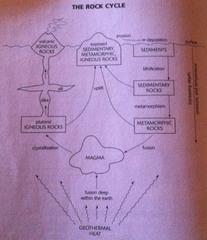
The rock cycle

answer
-Rocks are placed into groups according to how they form (sedimentary, igneous, metamorphic) -In the rock cycle, rocks change their shape and composition -The rock cycle is the process in which one type of rock changes into another
question
Sedimentary rocks

answer
-Composed of the fragments of other types of rocks -Often deposited in distinct parallel layers -Weather and erosion break down other rock types into sediments -Over time, the sediments become cemented and compacted and form into sedimentary rocks -The processes that form sedimentary rock occur at the surface of the earth and within bodies of water -Cover 75 to 80% of the earth's land area -Classified by the source of their sediments -Conglomerates are sedimentary rocks containing large fragments of other rock material -Sandstone is another example -Texture is important in classifying clastic sedimentary rocks -Chemical sedimentary rocks form when dissolved mineral solutions crystalize out of lakes and oceans -Rock salt (formed by sodium chloride) and limestone (formed from calcium carbonate) are examples of chemical sedimentary rocks -Limestone can contain organic or once-living matter and can record the history of that matter's formation in features such as strata, fossil evidence, and ripple marks
question
Igneous rocks

answer
-Classified according to composition and texture -Form when magma or lava cools and solidifies -Depending on the rate of cooling, some igneous rocks can contain visible crystals, while others can appear glassy -Temperature, pressure, and composition explain the three ways magma can form since they affect the melting point of rock -Igneous rock that cools beneath the earth's surface is called intrusive -Examples of intrusive rock formations include plutons, dikes, and batholiths -Igneous rock that forms on the earth's surface is called extrusive -Examples of extrusive rocks include obsidian, basalt, and pumice
question
Metamorphic rocks

answer
-Have undergone tremendous change from intense pressure and temperature -All examples of the rock cycle can change into metamorphic rock -Generally forms deep in the mantle as one type of rock changes into another -The mineral composition of the rock changes when the minerals in the rock recrystallize -Due to intense pressure, metamorphic rocks can show signs of bending and distortion -Examples of metamorphic rocks include schist, marble, gneiss, and slate -Usually classified according to texture and by chemical and mineral assemblage -Make up a large part of the earth's crust
question
Coral reef
answer
The result of the buildup of once-living things
question
Minerals
answer
-Natural chemical compounds that are the crystals that make up rocks -Each mineral has a specific composition or narrow range of composition -The most abundant minerals in the crust are the two feldspars (orthoclase and plagioclase), quartz, olivine, and augite ---These five minerals are silicates, built from interlocking silicon and oxygen atoms
question
Mineral hardness
answer
A method one could use to determine the hardness of unknown mineral samples would be: -Scratch test: Test the item against materials of known hardness; for example, use your fingernail or the graphite in a pencil to attempt to scratch the items. This process should result in assigning a relative hardness to the unknown items. -Mohs' scale of hardness: This scale assigns a fixed number to 10 reference materials. Talc (1) is the softest and diamond (10) is the hardest -Cleavage: breaking along flat surfaces -Density: how much matter is in the object
question
Mineral color
answer
Affected by factors such as weathering and impurities
question
Mountain
answer
-A land form that stretches above the surrounding land in a limited area, with a peak -Usually produced by the movement of lithospheric plates -The compressional forces, isostatic uplift, and intrusion of igneous matter forces surface rock upward, creating a land form higher than the surrounding features -The height of the feature makes it either a hill or, if higher and steeper, a mountain ---A mountain is generally steeper than a hill, but there is no universally accepted standard definition for the height of a mountain or a hill, although a mountain usually has an identifiable summit -The major mountains tend to occur in long linear arcs, indicating tectonic plate boundaries and activity -Two types of mountains are formed, depending on how the rock reacts to the tectonic forces: block mountains or fold mountains -Some isolated mountains were produced by volcanoes, including many apparently small islands that reach a great height above the ocean floor
question
River
answer
-A natural flow of water, usually freshwater, traveling toward an ocean, a lake, or another stream -In some cases, a river flows into the ground or dries up completely before reaching another body of water -Usually larger streams are called rivers, while smaller streams are called creeks, brooks, rivulets, rills, and many other terms -A component of the water cycle
question
Deserts
answer
-Take up about 1/3 of the earth's land surface -Usually have a large diurnal (day) and seasonal temperature range, with high daytime temperatures, and low nighttime temperatures (due to extremely low humidity) -The temperature in the daytime can reach 45°C/113° or higher in the summer, and dip to 0°C/32° or lower in the winter -Water acts to trap infrared radiation from both the sun and the ground, and dry desert air is incapable of blocking sunlight during the day or trapping heat during the night -Thus, during daylight, most of the sun's heat reaches the ground and as soon as the sun sets, the desert cools quickly by radiating its heat into space -Many deserts are formed by rain shadows
question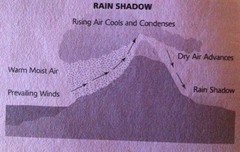
Rain shadow

answer
Mountains blocking the path of precipitation to the desert
question
Weathering
answer
The process of chemical or physical breakdown of earth rocks, soils, and their minerals
question
Mechanical/physical weathering
answer
The breakdown of rocks, soils and minerals through direct contact with atmospheric conditions such as heat, water, ice, and pressure
question
Chemical weathering
answer
The breakdown of rocks, soils and minerals through atmospheric chemicals or biologically produced chemicals (also known as biological weathering)
question
Soil
answer
-The materials left over after the rock breaks down combine with organic material to create soil -The mineral content of the soil is determined by the parent material; thus, a soil derived from a single rock type can often be deficient in one or more minerals for good fertility, while a soil weathered from a mix of rock types often makes more fertile soil
question
Erosion
answer
The movement (carrying away or displacement) of solids (sediment, soil, rock, and other particles), usually by the agents of currents such as wind, water, or ice by downward or down-slope movement in response to gravity
question
Erosion and land use
answer
-Erosion in many places is increased by human land use -Poor land-use practices include deforestation, overgrazing, unmanaged construction activity, and road building -Land that is used for the production of agricultural crops generally experiences a significantly greater rate of erosion than that of land under natural vegetation -This is particularly true if tillage is used, which reduces vegetation cover on the surface of the soil and disturbs both soil structure and plant roots that would otherwise hold the soil in place -Improved land-use practices can limit erosion by using techniques such as terrace building, conservation tillage practices, and tree planting -A certain amount of erosion is natural and healthy for the ecosystem, but excessive erosion can cause damage by excessive loss of soil
question
Strata
answer
-The layers of sediment deposited in a quiet environment -Common sites of deposition are lakes, deltas at the mouths of rivers, beaches and sandbars along the coast, and (most important) the marine environment -Commonly very extensive laterally and relatively thin vertically, like a blanket -Law of original horizontality: most sediments were deposited in beds that were originally horizontal, and any tilting is due to later earth movements -Law of superposition: younger beds were originally deposited above older beds
question
Fossils
answer
-Traces of ancient life preserved in the strata as shells, footprints, and the like -Soft plant and animal tissues decompose quickly in the presence of decay bacteria, which exist wherever oxygen exists -Therefore, softtissue would most likely avoid decomposition and survive as a fossil in the most oxygen-free environment, such as lake-bottom mud -Because life has evolved (changed) continually through geological history, the fossils in older strata differ from those found in more recent deposits Example: The earliest fossil-rich beds have many trilobites, early crab-like creatures that have been extinct for hundreds of millions of years; discovery of fossil trilobites in a formation permits assignment of that bed to an early period
question
The geological time scale
answer
-Used to arrange strata in a standard order -Used to measure the amount of radioactive decay in minerals and calculate the time at which the rock formed -The earth is believed to be about 5.6 billion years old -The fossiliferous strata record is only the last 11% of the earth's history -Human civilization has lasted only 10,000 years -The immensity of geological time is the major discovery of geology -There has been ample time for very slow processes to produce large consequences
question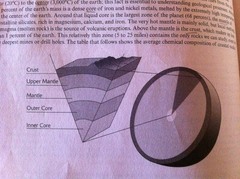
The earth's structure

answer
Has been inferred from its astronomical properties and seismic records of earthquake waves that have traveled through the interior of the earth -Center: 3000°C (temperature rises from the surface to the center) -Core: 31% of the earth's mass; iron and nickel metals, melted by the extremely high temperature of the center of the earth -Mantle: Largest zone of the planet (68%); crystalline silicates, rich in magnesium, calcium, and iron; very hot and mainly solid, but local melting to magma is the source of volcanic eruptions -Crust: Less than 1% of the earth; this relatively thin zone (5 to 25 miles) contains the only rocks we can study, even in the deepest mines or drill holes
question
Earth movements
answer
-The result of forces within the earth, where temperature and pressure differences lead to instability -The stress is particularly severe in orogenic zones, which are characterized by volcanism, metamorphism, deformation, and uplift ---Two styles of rock deformation are faulting and folding ---Edge-of-continent deformation is attributed to plate tectonics
question
Plate tectonics
answer
-Large-scale movements of the earth's lithosphere -The theory encompasses the older concepts of continental drift (first half of 20th century) and seafloor spreading (1960s) -The outermost part of the earth's interior is made up of two layers: the lithosphere and the asthenosphere -Lithosphere is comprised of the crust and the rigid uppermost part of the mantle -Lithosphere is broken up into tectonic plates (7 major and many minor) -The lithospheric plates ride on the asthenosphere ---------- -Giant masses of solid rock that float upon the earth's mantle -These plates move in relation to one another at one of three types of plate boundaries: convergent/collision boundaries, divergent/spreading boundaries, and transform boundaries -Earthquakes, volcanic activity, mountain-building, and oceanic trench formation occur along plate boundaries -The intensity of the earthquake depends on the type of tectonic motion that caused the initial earthquake -The lateral movement of the plates is typically at speeds of 50-100 mm annually
question
Continental drift
answer
-Theory that the earth's continents were originally united as a supercontinent, Pangaea -Established by Alfred Wegener in the early 1900s Examples to support Wegener's theory: -Paleontology: Fossil evidence indicates the similarity of fossils on both sides of the Atlantic Ocean -Continental "jigsaw puzzle": The outlines of the continents seem to fit together—for example, the eastern coast of South America and the western coast of Africa -Paleoclimatology (study of ancient climates): Ancient coral reefs (associated with warm water) are found in areas that could not currently support such growth -Sea-floor spreading: ---The discovery of tectonic plate movement and sea-floor spreading provided proof for Wegner's theory ---The oceanic floor is not stationary ---The plates move because of incredible amounts of released energy ---During sea-floor spreading, new oceanic crust forms ---The Mid-Atlantic Ridge is an example ---In response to ocean-floor movement, the ocean floor expands in opposite directions ---Continents spread apart and away from the Mid-Atlantic Ridge
question
Divergent plate movements
answer
-Occur when two plates pull away from each other -Such faults are generally weak and shallow Example: the Mid-Atlantic Range in the Atlantic Ocean
question
Convergent plate movements
answer
-Occur when two plates push together -Such faults are strong and relatively deep -Where the strongest earthquakes occur Example: mountain building in the Himalayas and the Andes
question
Transform plate movements
answer
-Occur when two plates slip past each other -Such faults are generally moderate and are relatively shallow Example: The San Andreas Fault
question
Pacific Ring of Fire
answer
-An area of frequent earthquakes and volcanic eruptions associated with the plate boundaries surrounding the Pacific Ocean -In a 40,000 km horseshoe shape, it is associated with a nearly continuous series of oceanic trenches, volcanic arcs, and volcanic belts and/or plate movements -Accounts for the majority of earthquakes and volcanoes worldwide -Has 452 volcanoes and is home to over 75% of the world's active and dormant volcanoes -90% of the world's earthquakes and 80% of the world's largest earthquakes occur along the Ring of Fire -The Ring of Fire is a direct result and consequent of plate tectonics and the movement and collisions of crustal plates
question
Volcano
answer
-An opening, or rupture, in a planet's surface or crust, which allows hot molten rock, ash, and gases to escape from below the surface -Volcanic activity involving the extrusion of rock tends to form mountains or features like mountains over a period of time -Volcanoes are generally found where tectonic plates are diverging or converging -A mid-oceanic ridge, such as the Mid-Atlantic Ridge, has examples of volcanoes caused by divergent tectonic plates pulling apart -The Pacific Ring of Fire has examples of volcanoes caused by convergent tectonic plates coming together -By contrast, volcanoes are not usually created where two tectonic plates slide past one another -Volcanoes can also form where there is stretching and thinning of the earth's crust -Can be caused by "mantle plumes"; these so-called hotspots, as in Hawaii, can occur far from plate boundaries -Hotspot volcanoes are also found elsewhere in the Solar System, especially on rocky planets and moons -Volcanoes are also found in subduction zones, where the denser oceanic plates are forced under continental plates; this adds massive volumes of water to the mantle, allowing magma to melt more readily and rise to the surface to form volcanoes
question
Cataclysmic volcanic eruptions
answer
-Can influence climate by sending tremendous volumes of dust, ash, and smoke into the atmosphere -The resulting dust layer would act as a shield, blocking out much of the sun's rays -This would result in lower global temperatures and a general cooling of the earth -Scientists theorize that massive volcanic eruptions on a global scale contributed to the earth's cooling, resulting in the onset of the Ice Age
question
Petroleum exploration
answer
-A continuous drill would find gas, oil, and water in that order -The three substances occur in their order of density, with the lightest substance on top and the heaviest on the bottom -Gas is lighter than the two liquids, and so it is on the top -Oil floats on water, and so it is second -On the bottom is the most dense substance, water
question
Meteorology
answer
-The science of the atmosphere and weather
question
Air mass
answer
-Characterized by similar temperatures and moisture levels -On maps, the characteristics of an air mass are represented by two letters -The lowercase letter represents moisture, and the uppercase letter represents temperature -Maritime air forms over water and is associated with wet air -Continental air forms over land and is associated with dry air -Polar air forms south of the Arctic and is cold -Tropical air forms over the Tropics and is warm -mT = maritime tropical (wet, warm air) -mP = maritime polar (wet, cold air) -cT = continental tropical (dry, warm air) -cP = continental polar (dry, cold air)
question
Hydrologic cycle
answer
-Sun heats water in the oceans -Water evaporates as vapor into the air -Ice and snow can sublimate directly into water vapor -Evapotranspiration: water transpired from plants and evaporated from the soil -Rising air currents take the vapor up into the atmopshere where cooler temperatures cause it to condense into clouds -Air currents move clouds around the globe and cloud particles collide, grow, and fall out of the sky as precipitation -Some precipitation falls as snow and can accumulate as ice caps and glaciers, which can store water for thousands of years -Snow packs can thaw and melt, and the ensuing water flows overland as snowmelt -Most precipitation falls back into the oceans or onto land, where the precipitation flows over the ground as surface runoff -A portion of runoff enters rivers, with stream flow moving water towards the oceans -Runoff and groundwater are stored as freshwater in lakes -Not all runoff flows into rivers; much of it infiltrates into the ground through percolation -Some water infiltrates deep into the ground and replenishes aquifers, which store huge amounts of freshwater for long periods of time -Some infiltration stays close to the land surface and can seep back into surface-water bodies (and the ocean) as groundwater discharge -Some groundwater finds openings in the land surface and emerges as freshwater springs -Over time, the water reenters the ocean, where the water cycle started
question
Hydrologic concepts
answer
-Precipitation -Canopy interception -Snowmelt -Runoff -Percolation -Subsurface flow -Evaporation -Sublimation -Condensation
question
Precipitation
answer
-Condensed water vapor that falls to the earth's surface -Most precipitation occurs as rain, but also includes snow, hail, fog drip, graupel, and sleet
question
Canopy interception
answer
The precipitation that is intercepted by plant foliage and eventually evaporates back to the atmosphere rather than falling to the ground
question
Snowmelt
answer
The runoff produced by melting snow
question
Runoff
answer
-The variety of ways by which water moves across the land -This includes both surface runoff and channel runoff -As it flows, the water may percolate into the ground, evaporate into the air, become stored in lakes or reservoirs, or be extracted for agricultural or other human uses
question
Percolation
answer
The movement of rainwater as it filters through soil and rocks into the ground, becoming groundwater
question
Subsurface flow
answer
-The flow of water underground, in the vadose zone and aquifers -Subsurface water may return to the surface (as a spring or by being pumped) or eventually seep into the oceans -Water returns to the land surface at lower elevation than where it entered, under the force of gravity or gravity-induced pressures -Groundwater tends to move slowly and is replenished slowly, and so it can remain in aquifers for thousands of years
question
Evaporation
answer
-The transformation of water from liquid to gas phases as it moves from the ground or bodies of water into the overlying atmosphere -The source of energy for evaporation is primarily through solar radiation -Evaporation often implicitly includes transpiration from plants, although together they are specifically referred to as evapotranspiration
question
Sublimation
answer
The state change where a solid (ice or snow) changes directly to a gas (water vapor)
question
Condensation
answer
The transformation of water vapor to liquid water droplets in the air, producing clouds and fog
question
Weather phenomena on earth
answer
-Common: wind, clouds, rain, snow, fog, dust storms -Less common: natural disasters such as tornadoes, hurricanes, and ice storms -Almost all familiar weather phenomena occur in the troposhere (the lower part of the atmosphere) -Weather does occur in the stratosphere and can affect weather lower down in the troposhere
question
Types of clouds
answer
-Cirrus -Stratus -Cumulonimbus -Altostratus
question
Cirrus clouds
answer
Featherlike clouds that indicate fair weather
question
Stratus clouds
answer
Smooth layers of low clouds that indicate a chance of drizzle or snow
question
Cumulonibus clouds
answer
Large, dark clouds that indicate thunderstorms
question
Altostratus clouds
answer
Piled in waves and indicate rain or snow
question
Why weather occurs
answer
-Weather occurs primarily due to density (temperature and moisture) differences between one location and another -These differences can occur due to the angle of the sun at any particular spot, which varies by latitude from the tropics -The farther from the tropics you are positioned, the lower the angle of the sun -This causes those locations to be cooler due to the indirect sunlight -The strong temperature contrast between polar and tropical air gives rise to the jet stream
question
Surface temperature differences
answer
-Cause pressure differences -A hot surface heats the air above it and the air expands, lowering the air pressure and its density -The resulting horizontal pressure gradient accelerates the air from high to low pressure, creating wind, and the earth's rotation then causes the curvature of the flow through the Coriolis effect -The atmosphere is a chaotic system, and so small changes to one part of the system can grow to have large effects on the system as a whole -This makes it difficult to accurately predict weather more than a few days in advance
question
Sun and oceans' affect on weather
answer
-The sun and oceans can also affect the weather of land -If the sun heats ocean waters for a period of time, water can evaporate -Once evaporated into the air, the moisture can spread over nearby land, thus making it cooler
question
Differential heating
answer
-The motive force behind land breezes and sea/lake breezes, also known as on- or off-shore winds -Land absorbs and radiates heat faster than water, but water releases heat over a longer period of time -The result is that, in locations where sea and land meet, heat absorbed over the day will be radiated more quickly by the land at night, cooling the air -Over the sea, heat is still being released into the air at night, and rises -This convective motion draws the cool land air in to replace the rising air, resulting in a land breeze in the late night and early morning -During the day, the roles are reversed -Warm air over the land rises, pulling cool air in from the sea to replace it, giving a sea breeze during the afternoon and evening
question
Mountain breezes and valley breezes
answer
-Due to a combination of differential heating and geometry -When the sun rises, it is the tops of the mountain peaks which receive first light, and as the day progresses, the mountain slopes take on a greater heat load than the valleys -This results in a temperature inequality between the two, and as warm air rises off the slopes, cool air moves up out of the valleys to replace it -This upslope wind is called a valley breeze -The opposite effect takes place in the afternoon, as the valley radiates heat -The peaks, long since cooled, transport air into the valley in a process that is partly gravitational and partly convective and is called a mountain breeze
question
El Niño and La Niña
answer
-Officially defined as sustained sea surface temperature anomalies of magnitude greater than 0.5°C across the central tropical Pacific Ocean -El Niño is characterized by unusually warm ocean temperatures in the eastern equatorial Pacific ---El Niño's warm current of nutrient-poor tropical water, heated by its eastward passage in the Equatorial Current, replaces the cold, nutrient-rich surface water of the Humboldt Current, also known as the Peru Current, which supports great populations of fish -La Niña is characterized by unusually warm ocean temperatures in the same area ---Atlanta tropical cyclone activity is generally enhanced during La Niña -The La Niña condition often follows the El Niño, especially when the latter is strong
question
Climate
answer
-Refers to the long-term weather patterns of a large geographical area and takes into account temperature, humidity, and precipitation -Latitude is the best determiner of climate, as it is consistently and directly correlated with temperature -The equator, at zero degrees latitude, generally has a tropical climate (warm and wet); at the extreme northern and southern latitudes (polar regions), the climate is very cold and dry -Rain shadows, as well as water currents, elevation and so forth, affect climate, but latitude is the primary factor
question
Estuary
answer
-A semi-closed coastal body of water with one or more rivers or streams flowing into it, and with a free connection to the open sea -Often associated with high levels of biological diversity -Typically the tidal mouths of rivers and are often characterized by sedimentation or silt carried in from terrestrial runoff, frequently from offshore -They are made up of brackish water -Often given names like bay, sound, fjord, etc.; the terms are not mutually exclusive -Ecosystems that are under threat from human activities such as pollution and overfishing
question
World/global ocean
answer
-Comprises one global, interconnected body of salt water often (though generally recognized as several separate oceans) -A continuous body of water with relatively free interchange among its parts -Major oceanic divisions are defined in part by the continents, various archipelagos, and other criteria: these divisions are (in descending order of size) the Pacific Ocean, the Atlantic Ocean, the Indian Ocean, the Southern Ocean and the Arctic Ocean -Smaller regions of the oceans are called seas, gulfs, bays, and other names -Oceans cover 3/4 of the earth's surface -The evaporation of these oceans is how we get most of our rainfall, and their temperature determines our climate and wind patterns -Life within the ocean had already evolved 3 billion years prior to the movement of animal and plant life on land
question
Surface ocean currents
answer
-Classified as warm-water or cold-water currents -Surface ocean temperature is a major determiner of coastal climate -The Gulf-Stream is a warm-water current that carries warm water from the Tropics to the Arctic regions of the North Atlantic Ocean -This accounts for higher temperatures and higher humidity on the Eastern Seaboard during the summer -The cold-water current that flows north to south off the California coast keeps the West Coast fairly cool during the summer -Cold-water currents create cooler temperatures in areas that would otherwise be much warmer
question
Tides

answer
-The rising of the earth's ocean surface caused by the tidal forces of the moon and the sun acting on the oceans -Cause changes in the depth of the marine and estuarine water bodies and produce oscillating currents known as tidal streams, making prediction of tides important for coastal navigation -The changing tide produced at a given location is the result of the changing positions of the moon and sun relative to the earth, coupled with the effects of the earth's rotation and the bathymetry of oceans, seas, and estuaries -Sea level measured by coastal tide gauges may also be strongly affected by wind -Tides may be semidiurnal or diurnal -The tidal force produced by the sun is 46% as large as that produced by the moon -The gravitational attraction between the moon and the earth (and to a lesser degree, the sun) causes the tides -The gravitational attraction of the moon causes the oceans to bulge out on the sides of the earth facing the moon -Another bulge also occurs on the opposite side of the earth as the earth is being pulled toward the moon -Due to the rotation of the earth, two tides occur each day
question
Semidiurnal
answer
-Two high waters and two low waters each day -In most locations, tides are semidiurnal
question
Diurnal
answer
One tidal cycle per day
question
Spring tide
answer
-Around a new or full moon, when the sun, moon, and the earth form a line, the tidal forces due to the sun reinforce those of the moon -The tide's range is at a maximum and is called a spring tide (spring as in "to jump/leap," not the season)
question
Neap tide/neaps
answer
-When the moon is at first quarter or third quarter, the sun, earth and moon form a 90-degree (right) angle with the earth at the vertex -The combined effect of this alignment of the sun, earth, and moon results in tidal ranges on the earth -When a neap tide occurs, the gravitational forces on the earth from both the sun and moon are minimized -Tidal range is lowest during neap tide
question
Tidal range
answer
The difference between levels of ocean water at high and low tides
question
Biology
answer
The science of life
question
Levels of life
answer
-Organic molecules -Cells -Organs -Individuals -Species -Communities
question
Fungi
answer
-Primitive plant group -Lack true roots, stems and leaves -Include molds, yeasts, and mushrooms -Lack chlorophyll and thus are incapable of manufacturing food, so they are either parasites or saprophytes
question
Parasites
answer
Prey on other living organisms
question
Saprophytes
answer
Exist on waste products and decaying organisms
question
Algae
answer
-Primitive plant group -Lack true roots, stems, and leaves -Range from a single cell to a huge seaweed -Mostly inhabit lakes and oceans
question
Lichens
answer
Two organisms, a fungus and an alga, living together symbiotically
question
Ferns
answer
Lack seeds and reproduce by means of spores, each of which may develop into a new plant without fertilization
question
Gymnosperms
answer
Cone-bearing plants (including pines) with seeds exposed on cone scales
question
Angiosperms
answer
Flowering plants that bear their seeds within fruits
question
Anaerobic organisms
answer
-Exist without free oxygen -Include many yeasts and bacteria -For these organisms, in the process of fermentation, glucose is changed into ethonol and carbon dioxide anaerobically -All forms of life require water for biochemical reactions, reproduce by means of nucleic acid (DNA), and contain carbon atoms
question
Ovule
answer
Small egg
question
Ovule in seed plants
answer
-In seed plants, the ovule is the structure that gives rise to and contains the female reproductive cells -After fertilization, the ovule develops into a seed
question
Ovule in flowering plants
answer
-In flowering plants, the ovule is located within the actual flower, the part of the carpel known as the ovary, which ultimately becomes the fruit -Depending on the plant, flowers may have one or multiple ovules per ovary -The ovule is attached to the placental wall of the ovary through a structure known as the funiculus (the plant equivalent of an umbilical cord)
question
Photosynthesis

answer
-A metabolic pathway that converts light energy into chemical energy -Plants use the energy in sunlight to convert carbon dioxide from the atmosphere, plus water, into simple sugars -These sugars are then used as building blocks and form the main structural component of the plant -Thus, plants absorb carbon dioxide and give off oxygen
question
Chlorophyll
answer
-A green-colored, magnesium-containing pigment that is essential to the photosynthesis process -It is generally present in plant leaves and often in other plant parts as well
question
Krebs cycle

answer
-The sugar made by plants can be oxidized later in a process that releases energy -The oxidation can be in the plant itself or in an animal that eats the plant -The release of energy by oxidation of sugar is respiration
question
Cell

answer
-The smallest amount of living matter, a bit of organic material that is the unit of structure and function for all organisms -Range in size from the smallest speck visible through an electron microscope to the yolk of the largest egg -Some tiny organisms like bacteria are one celled, but all larger organisms are composed of many cells arrayed in tissues -Although an isolated cell may be spherical, the cells packed together in plant or animal tissue have flattened walls -The essential subdivisions of a cell are the cell membrane, the cytoplasm, and the cell nucleus
question
Cell membrane
answer
Semi-permeable, allowing some substances to pass while excluding others
question
Cytoplasm
answer
-The main material within a cell -Varies in consistency from a fluid to a semisolid -Embedded in the cytoplasm are functional bodies: ---The centrosome (participates in cell division) ---Ribosomes (for constructing proteins) ---Mitochondria (conduct metabolism) ---Golgi bodies (involved in secretion) ---Vacuoles (used in digestion) ---Plastids (in plant cells, bodies with chlorophyll that carry out photosynthesis)
question
Cell nucleus
answer
-A membrane-enclosed organelle found in all eukaryotic cells -Contains most of a cell's genetic material, organized as multiple long and linear DNA molecules in complex with a large variety of proteins, such as histones, to form chromosomes -The genes within these chromosomes are the cell's nuclear genome -The function of the nucleus is to maintain the integrity of these genes and to control the activities of the cell by regulating gene expression
question
Chloroplasts
answer
-Organelles found in plant cells and eukaryotic algae that conduct photosynthesis -Absorb light and use it in conjunction with water and carbon dioxide to produce sugars, the raw material for energy and biomass production in all green plants and the animals that depend on them, directly or indirectly, for food -Capture light and are members of a class of organelles known as plastids
question
Mitochondrion
answer
-Plural: mitochondria -A membrane-enclosed organelle found in most eukaryotic cells -Sometimes described as cellular power plants because they generate most of the cell's supply of adenosine triphosphate (ATP), used as a source of chemical energy -In addition to supplying cellular energy, mitochondria are involved in a range of other processes, such as signaling, cellular differentiation, and cell death, as well as the control of the cell cycle and cell growth
question
Animals
answer
-Cannot perform photosynthesis and therefore derive their food from other organisms -Herbivores eat plants directly -Carnivores prey on other animals, but this food chain, too, ends in plants
question
Phylum
answer
-Plural: phyla -Plants and animals are classified into phyla on the basis of their cells, tissues, organs, and overall organization -Each phylum is a major group of organisms
question
Digestion
answer
-The breaking down of chemicals in the body into a form that can be absorbed -It is also the process by which the body breaks down chemicals into smaller components that can be absorbed by the blood stream ---Carbohydrates are converted to various sugars by the action of several enzymes, including ptyalin from saliva ---Fats are transformed to glycerol and fatty aids by the combined action of bile from the liver and the enzyme lipase from the pancreas ---Proteins are broken apart to their constituent amino acids ---The final products of digestion—sugars, glycerol, fatty acids, and amino acids—are absorbed into the bloodstream through the millions of projections (villi) lining the small intestine ---Once in the blood, these molecules are metabolized in the various body tissues ---------- -In mammals, preparation for digestion begins when saliva is produced in the mouth and digestive enzymes are produced in the stomach -Mechanical and chemical digestion begins in the mouth where food is chewed and mixed with saliva to break down starches -The stomach continues to break down food mechanically and chemically by churning and mixing the food with enzymes -After being processed in the stomach, food is passed to the small intestine -The majority of digestion and absorption occurs in the small intestine -Absorption occurs in the stomach and gastrointestinal tract, and the process finishes with defecation ---------- -Works with the circulatory system to provide the nutrients the system needs to keep the heart pumping
question
Metabolism
answer
-The sum of the chemical and physical processes in living organisms -Provides the basis for energy transfer, cell maintenance, and growth
question
Enzymes
answer
-Act as catalysts during the metabolic process -Without enzymes, many of the body's chemical reactions would not occur fast enough -The body uses enzymes to control its many thousands of chemical reactions, including the burning of food ---Lipase, for example, is an enzyme that helps in the digestion of fats
question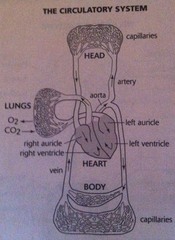
The circulatory system

answer
-An organ system that moves nutrients, gases, and wastes to and from cells, helps fight diseases, and stabilizes body temperature and pH to maintain homeostasis -Composed of the cardiovascular system, which distributes blood, and the lymphatic system, which distributes lymph -Humans and other vertebrates have a closed cardiovascular system, meaning the blood never leaves the network of arteries, veins, and capillaries -Works with the digestive system to provide the nutrients the system needs to keep the heart pumping -Includes pulmonary circulation and systemic circulation
question
Homeostasis
answer
Allows an individual to maintain a stable internal environment, regardless of changes in the external environment Examples: -A person's body temperature remains at 37°C (98.6°F) even if the air outside is much cooler -Perspiration on a hot day is another example of your body maintaining homeostasis -Stress is a key factor in triggering body changes that protect the individual; for example, blood to the brain increases, heart rate increases, sweating increases, and the digestive system slows. After the stressful situation subsides, the body returns to a normal metabolic state
question
Pulmonary circulation
answer
A loop through the lungs where blood is oxygenated
question
Systemic circulation
answer
A loop through the rest of the body to provide oxygenated blood
question
Cardiovascular system
answer
Formed by blood, heart, and blood vessels
question
Blood
answer
-An average adult contains 5 to 6 quarts (roughly 4.7 to 5.7) liters of blood -Blood is composed of plasma, red blood cells, white blood cells, and platelets
question
Plasma
answer
Dissolves nutrients, wastes, hormones, antibodies, and enzymes
question
Red blood cells
answer
Transport oxygen in combination with the iron pigment, hemoglobin
question
White blood cells
answer
Fight infection
question
Platelets
answer
Initiate the clotting necessary to stop bleeding after a wound
question
Heart
answer
-Pumps oxygenated blood to the body and deoxygenated blood to the lungs -In the human heart, there is one atrium and and one ventricle for each circulation, and with both a systemic and pulmonary circulation, there are four chambers in total: left atrium, left ventricle, right atrium, and right ventricle ---The right atrium, which is the upper chamber of the right side of the heart, receives blood from the upper body through the superior vena cava, and from the lower body through the inferior vena cava
question
Lymphatic system
answer
Formed by the lymph, lymph nodes, and lymph vessels
question
Respiratory system
answer
-In living organisms, the function of the respiratory system is to allow for gas exchange -The space between the alveoli and the capillaries the anatomy or structure of the exchange system, and the precise physiological uses of the exchanged gases vary, depending on the organisms
question
Respiratory system in mammals
answer
-Anatomical features include airways, lungs, and the respiratory muscles -Molecules of oxygen and carbon dioxide are passively exchanged, by diffusion, between the gaseous external environment and the blood -This exchange process occurs in the alveolar region of the lungs
question
Respiratory system in other animals
answer
-Have very simple anatomical features -In amphibians, even the skin plays a vital role in gas exchange
question
Respiratory system in plants
answer
-The directionality of as exchange can be opposite to that in animals -Includes anatomical features such as holes on the undersides of leaves known as stomata
question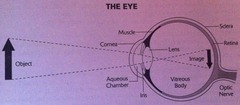
The sensory system

answer
-Includes those specialized structures that initiate a nerve impulse after being affected by the environment -The eyes are the organs of vision -Light rays are refracted as they pass through the cornea, lens, and vitreous body to focus on the retina, where an image is formed -The optic nerve then carries impulses from the light-sensitive cells of the retina to the brain
question
The nervous system
answer
-Composed of the brain, spinal cord, and peripheral nerves that extend throughout the body -Functional unit of the nervous system is the neuron
question
Neuron

answer
-A nerve cell with short dendrites that carry electrical impulses to the body, and a long axon, the outgoing fiber along which the impulse is transmitted further -Sensory neurons conduct signals from the sense organs to the central nervous system, the spinal cord, and the brain -Motor neurons transmit signals from the central nervous system to muscles
question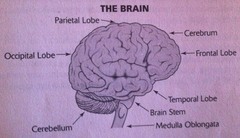
The brain

answer
-The hindbrain (cerebellum and medulla oblongata) operates unconsciously and automatically to regulate vital functions like circulation, respiration, excretion, and muscle tension -The cerebrum is the largest part of the brain; it receives information from the senses and makes conscious decisions
question
Organisms
answer
-Complex chemical systems, organized in ways that promote reproduction and some measure of sustainability or survival -It is generally the phenomena of entire organisms that determine their fitness to an environment and therefore the survivability of their DNA-based genes -Owe their origin, metabolism, and many other internal functions to chemical phenomena, especially the chemistry of large organic molecules -Semi-closed chemical systems -Although they are individual units of life, they are not closed to the environment around them -To operate, they constantly take in and release energy -Are either autotrophs or heterotrophs
question
Autotrophs
answer
Produce usable energy (in the form of organic compounds), using light from the sun or inorganic compounds
question
Heterotrophs
answer
Take in organic compounds from the environment
question
Carbon
answer
-The primary chemical element in these compounds -Has a great affinity for bonding with other small atoms, including other carbon atoms -Its small size makes it capable of forming multiple bonds and makes it ideal as the basis of organic life -It is able to form small compounds containing three atoms (such as carbon dioxide), as well as large chains of many thousands of atoms that are able to store data (nucleic acids), holds cells together, and transmit information (protein)
question
Ecology
answer
-A branch of biology -Each living organism has an ongoing and continual relationship with every other element that makes up its environment
question
Ecosystem
answer
-The sum total of interacting living organisms and their non-living environment (the biotope) in an area -Run on energy captured from the sun by primary producers through photosynthesis -This energy then flows through the food chains to primary consumers (herbivores who eat and digest the plants), and on to secondary and tertiary consumers (either carnivores or omnivores) -Energy is lost as waste heat to living heat organisms when they use it to do work -Can be divided into terrestrial ecosystems, freshwater ecosystems, and marine ecosystems
question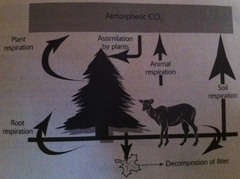
Biogeochemical cycle

answer
-The entire movement of chemicals in an ecosystem -Includes the carbon and nitrogen cycle ---Matter is incorporated into living organisms by the primary producers ---Photosynthetic plants fix carbon from carbon dioxide, and nitrogen from atmospheric nitrogen or nitrates present in the soil, to produce amino acids ---Much of the carbon and nitrogen contained in ecosystems is created by such plants and is then consumed by and incorporated into secondary and tertiary consumers ---Nutrients are usually returned to the ecosystem through decomposition
question
Terrestrial ecosystems
answer
Forest ecosystems, steppes, savannas
question
Freshwater ecosystems
answer
Lakes, ponds, and rivers
question
Population
answer
All members of a given species that live in a defined geographic area
question
Adaptation
answer
-A characteristic of an organism that has been favored by natural selection and increases the fitness of its possessor -The change in living organisms that allows them to live successfully in an environment -Enable living organisms to cope with environmental stresses and pressures -Can be structural, behavioral, or physiological
question
Structural adaptations
answer
Special body parts of an organism that help it to survive in its natural habitat (e.g. skin color, shape, and body covering)
question
Behavioral adaptations
answer
Special ways a particular organism behaves to survive in its natural habitat (e.g. phototropism)
question
Phototropism
answer
-The movement of a plant in reaction to a stimulus (a light source) -The plant bends toward the light source due to complex chemical changes
question
Geotropism
answer
Refers to the roots of a plant growing toward the center of the earth due to graity
question
Physiological adaptations
answer
Systems present in an organism that allow it to perform certain biochemical reactions (e.g. making venom, secreting slime, and homeostasis)
question
Ecosystem relationships
answer
-Primarily governed by stochastic (chance) events, the reactions these events provoke on non-living material, and the responses by organisms to the conditions surrounding them -Thus, an ecosystem results from the sum of individual responses of organisms to stimuli from events in the environment -The presence or absence of populations merely depends on reproductive and dispersal success, and population levels fluctuate in response to stochastic events -If the number of species in an ecosystem is higher, then the number of stimuli is also higher
question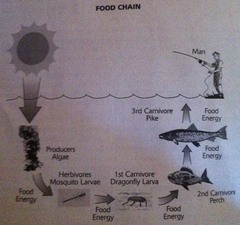
Food chains

answer
-Describe the eating relationships between species within an ecosystem -The flow of energy from one organism to the next and to the next, and so on -Show how the energy from the producer is given to the consumer -Organisms in a food chain are grouped into trophic levels, based on how many links they are removed from the primary producers -Trophic levels may contain either a single species or a group of species that are presumed to share both predators and prey -They usually start with a plant and end with a carnivore
question
Organisms in the food chain
answer
-Producers -Primary consumers -Secondary consumers -Tertiary consumers -Decomposers
question
Producers
answer
-Organisms in an ecosystem that produce biomass from inorganic compounds (autotrophs) -The green plants in an ecosystem that can manufacture their own food through the process of photosynthesis
question
Primary consumers
answer
-Herbivores/plant eaters -Can range in size from insects to elephants
question
Secondary consumers
answer
-Carnivores -They feed on the primary consumers and are meat eaters
question
Tertiary consumers
answer
Organisms that feed on smaller primary and secondary consumers
question
Decomposers
answer
-Organisms that consume dead organisms and in doing so, carry out the natural process of decomposition -Like herbivores and predators, decomposers are heterotrophic -This means that they use organic substrates to get their energy, carbon, and nutrients for growth and development -Use deceased organisms and non-living organic compounds as their food source -The primary decomposers are bacteria and fungi
question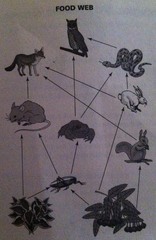
Food webs

answer
-Interconnected energy systems -Demonstrates the alternate energy links available to an organism -Help explain predator/prey relationships in an ecosystem and include networks of food chains
question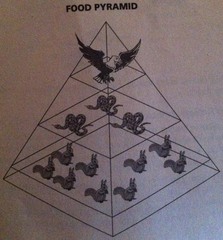
Food pyramids

answer
-Illustrate energy flow in an ecosystem -The base of the pyramid (producers) supports all of the other levels of the pyramid -At each succeeding level of the food pyramid, there is a decrease in available energy
question
Life cycle
answer
- All living things have a life cycle -Represents the stages an organism goes through from birth to death
question
Metamorphosis
answer
A distinct change in a physical appearance an organism can go through between birth and adulthood
question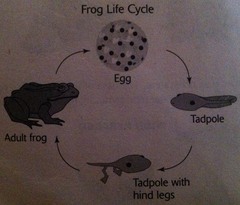
Frog life cycle

answer
1. Egg 2. Tadpole 3. Froglet 4. Adult frog
question
Frog life cycle: egg
answer
-A female frog generally lays thousands of eggs in water -The eggs are highly vulnerable to predators, so frogs have evolved many techniques to ensure the survival of their next generation
question
Frog life cycle: tadpole
answer
-The eggs hatch and life continues as tadpoles -They lack lungs, eyelids, and front and hind legs -Tadpoles are typically herbivorous, feeding mostly on algae
question
Frog life cycle: froglet
answer
-At the end of the tadpole stage, frogs undergo metamorphosis and they transition into adult form -Metamorphosis involves a dramatic transformation of morphology and physiology, as tadpoles develop hind legs, then front legs, lose their gills, and develop front lungs
question
Frog life cycle: adult frog
answer
-In the final stage of development, the froglet evolves into an adult frog -After metamorphosis, young adults may leave the water and disperse into terrestrial habitats, or continue to live in the aquatic habitat as adults
question
Butterfly life cycle

answer
The butterfly life cycle is unlike that of many insects. Butterflies go through a complete metamorphosis. -Egg/embryonic stage -Larva/caterpillar/feeding stage -Pupa/chrysalis/cocoon stage -Adult butterfly/imago stage
question
Butterfly life cycle: egg
answer
-The eggs are usually laid on plants -This stage lasts a few weeks for most butterflies
question
Butterfly life cycle: larva
answer
-From the eggs, butterfly larvae, or caterpillars, consume plant leaves and spend practically all of their time in search of food -Although most caterpillars are herbivorous, a few species are insect eating -When the larva is fully grown, hormones are produced -At this point, the larva stops feeding and begins wandering in the quest of a suitable pupation site, often the underside of a leaf
question
Butterfly life cycle: pupa
answer
The larva transforms into a pupa (or chrysalis) by anchoring itself to a substrate and molting for the last time
question
Butterfly life cycle: adult butterfly
answer
-The adult, sexually mature, stage of the insect is known as the imago -After it emerges from its pupa stage, a butterfly cannot fly until the wings are unfolded
question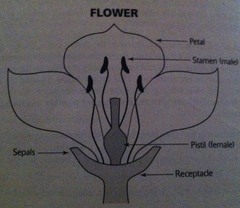
Reproduction of flowering plants

answer
-Flowering plants reproduce by sexual and asexual means and are the dominant plant form on land -Reproductive organs are called flowers -The anther produces male gametophytes, the sperm is produced is pollen grains, which attach to the stigma on top of a carpel, in which the female gametophytes (inside ovules) are located -After the pollen tube grows through the carpel's style, the sex cell nuclei from the pollen grain migrate into the ovule to fertilize the egg cell -The resulting zygote develops into an embryo -The ovary, which produced the female gametophyte(s), then grows into a fruit, which surrounds the seed(s) -Plants may either self-pollinate or cross-pollinate
question
Reproduction of non-flowering plants
answer
Nonflowering plants like ferns, moss, and liverworts use other means of sexual reproduction
question
Asexual reproduction
answer
-A form of reproduction which does not involve meiosis, or fertilization -Only one parent is involved in asexual reproduction -The primary form of reproduction for single-celled organisms such as the archaea, bacteria and protists -Many plants and fungi reproduce asexually as well
question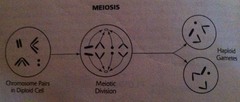
Meiosis (overview)

answer
-A process of reductional division in which the number of chromosomes per cell is cut in half -In animals, meisois always results in the formation of gametes, while in other organisms it can give rise to spores -Essential for sexual reproduction and therefore occurs in all eukaryotes (animals, plants, fungi, and protists) that reproduce sexually -Does not occur in archaea or bacteria, which reproduce through asexual processes such as binary fission -Uses many of the same biochemical mechanisms employed during mitosis to accomplish the redistribution of chromosomes -Pairing and genetic recombination between homologous chromosomes
question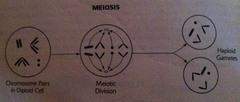
Meiosis (process)

answer
-During meiosis, the genome of a diploid germ cell undergoes DNA replication, resulting in four haploid cells -Each of these cells contains one complete set of chromosomes, or half of the genetic content of the original cell -If meiosis produces gametes, these cells must fuse during fertilization to create a new diploid cell, or zygote, before any new growth can occur -Because the chromosomes of each parent undergo genetic recombination during meiosis, each gamete, and thus each zygote, will have a unique genetic blueprint encoded in its DNA -Together, meiosis and fertilization generate genetically distinct individuals in populations
question
Meiosis in plants
answer
-In all plants and in may protists, meiosis results in the formation of haploid cells that can divide vegetatively without undergoing fertilization -These cells are referred to as spores -In these groups, gametes are produced by mitosis
question
Mitosis

answer
-Cell division -Division of the parent cell's genome into two daughter cells -The genome is composed of a number of chromosomes that contain genetic information vital for proper cell function -Because each resultant daughter cell should be genetically identical to the parent cell, the parent cell must take a copy of each chromosome before mitosis -This occurs during S phase, the interphase period that precedes the miotic phase in the cell cycle where preparation for mitosis occurs -Each new chromosome now contains two identical copies of itself, called sister chromatids, attached together in a specialized region of the chromosome known as the centromere
question
Sister chromatids
answer
-The chromosomes align themselves in a line spanning the cell -Microtubules, essentially miniature strings, play out from opposite ends of the cell and shorten, pulling apart the sister chromatids of each new chromosome -As the cell elongates, corresponding sister chromosomes are pulled toward opposite ends and a new nuclear envelope forms around the separated sister chromosomes -Eventually, the mother cell will be split in half, giving rise to two daughter cells, each with an equivalent and complete copy of the original genome
question
Natural selection
answer
-The process by which favorable and heritable traits become more common in successive generations of a population of reproducing organisms, and unfavorable heritable traits become less common -The mechanism by which evolution may take place within a given population of organisms -One of the cornerstones of modern biology -Was introduced by Charles Darwin in "The Origin of Species"
question
Phenotype
answer
-Observable characteristics of an organism -Individuals with favorable phenotypes are more likely to survive and reproduce than those with less favorable phenotypes -The phenotype's genetic basis will increase in frequency over the following generations -Over time, this process may result in adaptations that specialize organisms for particular ecological niches and may eventually result in the emergence of new species
question
The Origin of Species
answer
-Charles Darwin's groundbreaking 1859 book that described natural selection -The concept of natural selection was originally developed in the absence of a valid theory of inheritance -At the time of Darwin's writing, nothing was known of modern genetics
question
Gregor Mendel
answer
-The father of modern genetics -A contemporary of Darwin's -His work lie in obscurity until the early 20th century
question
Darwin's theory of evolution
answer
-Survival of the fittest -Natural selection -Evolution of species over time -Genetic variation through geographic isolation Organisms that failed to adapt often perished with or without leaving descendants
question
Ozone depletion
answer
-The breakdown of the ozone layer is primarily the result of an increase in chlorofluorocarbons (CFCs) in the atmosphere -CFCs are found in products used for refrigeration, air conditioning, insulation, or any products that use Freon -Ozone depletion was detected over Antarctica -An increase in UV radiation, which the ozone layer blocks, could alter the genetic makeup of phytoplankton (the tiny organisms at the beginning of the food change) -That same increase in UV could lead to an increase in skin cancer -Ozone depletion is not directly related to the greenhouse effect
question
Greenhouse effect
answer
A warming trend caused by an increase in atmospheric carbon dioxide
question
Genetic mutation
answer
-For a mutation to be passed on, the genetic material must be passed on through breeding -A mutation is the result of change in the makeup of the chromosomes, which contain the genes that determine the characteristics of an organism -When changes occur in sex cells, the result can be significant -Mutations can be both successful and unsuccessful, with beneficial changes being preserved through natural selection
question
Stages of mitosis

answer
1. Interphase: The cell grows to its mature size. The cell is preparing to divide into two cells and make a copy of its DNA. 2. Prophase: The chromatin in the nucleus condenses condenses to form chromosomes. The centromere holds the two chromatids of a chromosome together. Spindle fibers form a bridge between the ends of the cell. 3. Metaphase: The chromosomes are lined up along the center of the cell. The chromosomes attach to the spindle fibers developed during prophase. The centromere holds the chromatids together. 4. Anaphase: The centromeres split and the two chromatids separate. The chromatids move to opposite ends of the spindle fiber. The cell is preparing for cell division and becomes stretched as the opposite ends pull apart. 5. Telophase: The chromosomes begin to stretch out in both regions at the end of the cell. A new nuclear membrane forms around each area of the chromosome. The cell is now ready for division into two daughter cells with identical chromosomes.
question
Physical sciences
answer
The branches of natural sciences that study the nature and properties of energy and non-living matter
question
Matter
answer
-Anything that has mass and occupies space -Everything you see and touch is composed of matter -Three states of matter are solids, liquids, and gases
question
Solids
answer
-Characterized by their ability to retain their shape -Relatively incompressible -Melt when heated and vaporize only slightly -All substances become solid if cooled sufficiently Examples: rocks, crystals, wood, feather, ice
question
Liquids
answer
-Take on the shape of their containers, yet cannot be compressed to any significant extent -The volume of a liquid is constant unless evaporation is occurring -Liquids when chilled sufficiently, while heat causes liquids to vaporize -The liquid state is intermediate between the solid and gaseous states with regard to molecular motion and attractive forces between molecules Examples: water, oil, milk, honey
question
Gases
answer
-Expand to fill any available space -A gas is a compressible fluid, with its volume determined by the pressure and temperature of the environment -A compressed gas pushes out equally in all directions -Boyle's Law: If the pressure increases, the volume decreases; the reverse is true as well -Charles's Law: As temperature increases (at a fixed pressure), so does volume Examples: air, helium, steam
question
Sublimination
answer
Makes it possible for some elements and compounds to transition from a solid to gas phase without becoming a liquid Example: a block of dry ice (CO2), which will turn into a gas at room temperature
question
Deposition
answer
Some gases can transition directly to a solid Example: the formation of frost
question
Mass
answer
-The amount of matter in a chemical substance -In everyday usage, mass is commonly confused with weight
question
Weight
answer
-In physics and engineering, weight means the strength of the gravitational pull on the object (how heavy it is, measured in newtons) -In everyday situations, the weight of an object is proportional to its mass, which usually makes it acceptable to use the same word for both concepts
question
Density
answer
-For a homogeneous object, density is determined by dividing the mass by the volume (D = M/V) -The mass is normally measured with an appropriate scale or balance -The volume may be measured directly (from the geometry of the object) or by the displacement of a fluid Example: If steel and wood have equal dimensions, the steel would have a greater mass as it is more dense
question
Hardness
answer
-Refers to various properties of matter in the solid phase that give it a high resistance to its shape changing when force is applied -Hard matter is contrasted with soft matter -However, the behavior of solid materials under force is complex, resulting in several different scientific definitions of what might be called hardness in everyday usage -Three principal operational definitions of hardness: scratch hardness, indentation hardness, and rebound hardness
question
Scratch hardness
answer
Resistance to fracture or plastic (permanent) deformation due to friction from a sharp object
question
Indentation hardness
answer
Resistance to plastic (permanent) deformation due to a constant load from a sharp object
question
Rebound hardness
answer
Height of the bounce of an object dropped o the material, related to elasticity
question
Mohs' scale of hardness
answer
-Rates minerals and puts them on a scale from 1 to 10 (1 is the softest and 10 is the hardest) determined by the ability of a harder mineral to scratch a softer mineral -Talc is at 1 and diamond is at 10
question
Physical properties
answer
-The characteristics that makes up the physical composition of a substance -Include color, form, electrical conductivity, and density
question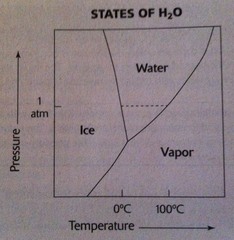
Physical changes

answer
-Involve one substance changing states (not one substance changing into another) -Typically reversible Example: water -Can change from a gas (water vapor) to a liquid (water) to a solid (ice), but the water molecules do not change -The particular state of water is determined by pressure and temperature -The dashed lines show the behavior of water at one atmosphere (sea level), freezing at 0°C (32°F), and boiling at 100°C (212°F) -At other pressures, the freezing and boiling temperatures for water differ from the familiar values
question
Chemical changes
answer
-A change of one substance into a different substance -Occurs whenever compounds are formed or decomposed -During this reaction, there is a rearrangement of atoms that makes or breaks chemical bonds -This change is usually not reversible, unlike physical changes Example: The formation of rust -Iron chemically reacts with air and water to form rust (ferrous oxide) and is unable to change back to iron
question
Chemical reactions
answer
Show the number of molecules or formula units of the reactants and products Example: nitrous oxide is a colorless, odorless gas that causes mild hysteria when inhaled, hence the name laughing gas; it is prepared by heating ammonium nitrate crystals
question
Atoms

answer
-Made up of several tiny parts -At the center of an atom is a core called the nucleus -The nucleus is made up of particles called protons and neutrons -Protons have a positive electrical charge, and neutrons have no charge -Electrons move around the nucleus in electron clouds -Electrons have a negative charge, and they are attracted to the positively charged protons in the nucleus -This attraction keeps the electrons in orbit around the nucleus
question
Chemical elements
answer
-Composed of only one atom and cannot be separated into different substances except in some instances by radioactive decay or by nuclear reactions -Elements are assigned atomic numbers equal to the number of protons in the nucleus of their atoms -Each element has a different number of protons -The sum of the protons and neutrons gives an average atomic mass for the element
question
Hydrogen
answer
Symbol: H Protons: 1 Neutrons: 0 Mass: 1
question
Helium
answer
Symbol: He Protons: 2 Neutrons: 2 Mass: 4
question
Carbon
answer
Symbol: C Protons: 6 Neutrons: 6 Mass: 12
question
Oxygen
answer
Symbol: O Protons: 8 Neutrons: 8 Mass: 16
question
Iron
answer
Symbol: Fe Protons: 26 Neutrons: 30 Mass 56
question
Uranium
answer
Symbol: U Protons: 92 Neutrons: 146 Mass: 238
question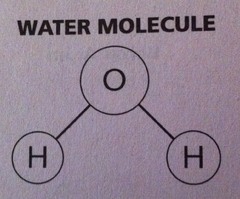
Compounds

answer
Formed by the chemical combination of two or more elements in a fixed ratio Example: water -Made up of molecules with the composition H20 and the structure (arrangement) shown in the picture -The straight lines denote bonds -One water molecule is built from two atoms of hydrogen and one atom of oxygen Example: table salt -A compound composed of one atom of sodium and one atom of chlorine (NaCl, sodium chloride)
question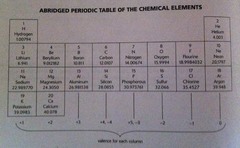
The periodic table of the elements

answer
-Arranges all of the known elements from left to right and top to bottom in order of increasing atomic number, and they generally coincide with their increasing atomic mass -Elements with similar properties fall into the same vertical columns to form groups or families -Properties of elements change greatly across any one row (period) -In each element's square, the chemical symbol is in the middle, the atomic weight is usually directly below the symbol, the atomic number is usually shown at the top of the square -As of 2006, the table contains 117 chemical elements whose discoveries have been confirmed -94 are naturally found on the earth, and the rest are synthetic elements that have been produced artificially in particle accelerators
question
Atomic number
answer
-The number of protons of that element -No two elements have the same atomic number -Elements in the periodic table are arranged in order of increasing atomic number
question
Metals in the periodic table
answer
-Metals account for the vast majority of the elements in the periodic table -Show a wide range of chemical and physical properties -Most metals are good conductors of heat and electricity, and some, like iron and cobalt, are magnetic -Many metals in the periodic table are alkali metals, such as sodium and potassium; these metals are very reactive
question
Non-metals in the periodic table
answer
-Account for 17 elements in the periodic table -Lack the properties of metals but are very common -Include oxygen, nitrogen, and carbon, 7 metalloid elements, and 7 gases -Poor conductors of electricity
question
pH
answer
-A measure of the acidity or basicity of a solution -The pH scale is not an absolute scale; it is relative to a set of standard solutions whose pH is established by international agreement -pH measurements are important for medicine, biology, chemistry, food science, environmental science, oceanography, and many other applications
question
Solution

answer
-When foreign substances are dissolved in water it creates a solution -Solutions with a pH of less than 7.0 are said to be acidic, and solutions with a pH greater than 7.0 are said to be basic or alkaline
question
Litmus
answer
-A water-soluble mixture of different dyes extracted from lichens -It is often absorbed onto filter paper -The resulting piece of paper or solution with water becomes a pH indicator (one of the oldest), used to test materials for acidity -Turns red under acidic conditions, and turns blue under basic (i.e., alkaline) conditions -Other indicators of the presence of an acid are that when acids react with metals, hydrogen gas is released causing bases to feel soapy when touched
question
Mixture
answer
-Made by combining two or more different materials without a chemical reaction occurring (the objects do not bond together) -They are the product of a mechanical blending or mixing of chemical substances -Each ingredient substance retains its own chemical properties and makeup (for example, a mixture of salt and pepper would still be identifiable as -While there are no physical changes in a mixture, the chemical properties of a mixture, such as its melting point, may differ from those of its components -Mixtures can usually be separated into their original components by mechanical means -Either homogeneous or heterogeneous
question
Measurement
answer
-The beginning of scientific wisdom -The physicist's first reaction to a new idea is to ask: Can it be measured? Can I describe it with numbers?
question
Motion
answer
-A constant change in the location of a body -Described by stating an object's position, velocity and acceleration
question
Velocity
answer
The rate of change of position with time v = ?d/?t (velocity = change of distance/change of time) Example: An automobile that is 100 miles farther along a highway at 3 p.m. than at 1 p.m. has an average velocity during the interval of: 100 miles/2 hours = 50 miles/hour
question
Acceleration
answer
The rate of change of velocity with time a = ?v/?t (acceleration = change of velocity/change of time) Example: An automobile had an initial velocity of 40 mph at 1 p.m. and a final velocity of 60 mph at 3 p.m., then its average acceleration would be: (20 miles/hour)/2 hours = 10 miles/hour² or 10 mile/hour/hour
question
Newton's first law of motion
answer
-The law of inertia -Without outside forces (such as gravity or friction), an object at rest will remain at rest, while an object in motion will never stop or deviate from its course
question
Newton's second law of motion
answer
-Relies on the the first law -The acceleration of an object is proportional to the force applied (the more force, the more acceleration)
question
Newton's third law of motion
answer
For every action (applied force), there is an equal and opposite reaction
question
Gravitation
answer
-A natural phenomenon by which objects with mass attract one another -Compels dispersed matter to coalesce, and thus it accounts for the very existence of the earth, the sun, and most of the macroscopic objects in the universe -Responsible for keeping the earth and the other planets in their orbits around the sun, for keeping the moon in its orbit around the earth, for the formation of tides, for convection (by which hot fluids rise), for heating the interiors of forming stars and planets to very high temperatures, and for various other phenomena that we observe
question
Gravity
answer
-The terms gravitation and gravity are mostly interchangeable in everyday use -Gravity refers specifically to the gravitational force exerted by the earth on objects in its vicinity
question
Magnetism
answer
-Displayed by permanent magnets and around electric currents -The north pole of one magnet attracts the south pole of another, but like poles repel each other -Either pole can attract unmagnetized iron objects -Iron filings spread out on a piece of paper above a bar magnet become arranged in a pattern that maps a magnetic field in the space around the magnet -The earth's magnetic field orients the iron needles of navigational compasses -An electric current also generates a magnetic field, demonstrating an intimate connection between electricity and magnetism
question
Simple machine
answer
-A mechanical device that changes the direction or magnitude of a force -The simplest mechanisms that use mechanical advantage to multiply force -Uses a single applied force to do work against a single load force -Ignoring friction losses, the work done on the load is equal to the work done by the applied force -Simple machines can be used to increase the amount of the output force, at the cost of a proportional decrease in the distance moved by the load -Allow the individual to obtain a mechanical advantage
question
Mechanical advantage
answer
-The ratio of the output to the input force -Also called leverage -Results in less force applied over a greater distance -Helps to make work easier
question
The six classical simple machines
answer
-Lever -Pulley -Inclined plane -Screw -Wedge -Wheel and axle
question
Lever

answer
-A rigid object that is used with an appropriate fulcrum or pivot point to multiply the mechanical force that can be applied to another object -Examples: wheelbarrow (the wheel works as the fulcrum), scissors (the fulcrum is where the blades cross)
question
First-class lever
answer
Can multiply force or distance depending on the location of the fulcrum End: Output force Middle: Fulcrum Other end: Input force Examples: seesaws, scissors, pliers
question
Second-class lever
answer
Multiply force but do not change the direction of the input force End: Fulcrum Middle: Output force Other end: Input force Examples: wheelbarrows, baby strollers, bottle openers
question
Third-class lever
answer
Top: Output force (resistance) Middle: Input force (effort) End: Fulcrum Examples: baseball bat, fishing pole, shovel
question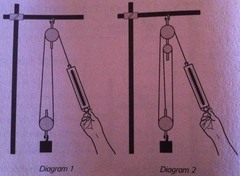
Pulley/block

answer
-A grooved wheel with a rope or other item wrapped around it -Pulleys are used to change the direction of an applied force, change the amount of force, transmit rotational motion, or realize a mechanical advantage in either a linear or a rotational system of motion -A pulley helps an individual lift an object by spreading the weight of the object over the length of the rope Example: -Raising and lowering window blinds -Diagram 1 represents a double pulley. As effort is applied (pulling power), the load (weight) is raised. In this system, the load moves only half the distance that the rope is pulled. However, the force raising the load is double the effort pulling the rope. In this system, the pulleys provide a 2-to-1 mechanical advantage. -Diagram 2 represents a multiple-pulley system. In this system, less strength is used to accomplish the same lifting height as in diagram 1. The workload does not change; however, less force, and consequently less effort, is needed. In this system, the load moves one-third the distance that the rope is pulled, and the pulleys provide a 3-to-1 mechanical advantage. -In both diagrams, the top pulley is only a change of direction and does not provide any type of mechanical advantage.
question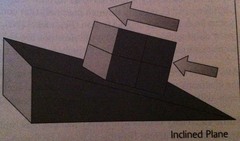
Inclined plane

answer
-A flat surface whose endpoints are at different heights, resulting in a slope -By moving an object up an inclined plane rather than completely vertically, the amount of force required is reduced, at the expense of increasing the distance the object must travel -Mechanical advantage of an inclined plane is the ratio of the length of the sloped surface to the height it spans -The inclined plane allows the same work to be done with a smaller force exerted over a greater distance Example: ramp
question
Screw

answer
-All screws are inclined planes -Can convert a rotational force (torque) to a linear force, and vice versa -The ratio of threading determines the mechanical advantage of the machine -More threading increases the mechanical advantage -It is easier to turn a screw than to push a screw directly into a wall -As the screw rotates outward, the weight rises; as the screw rotates inward, the weight lowers
question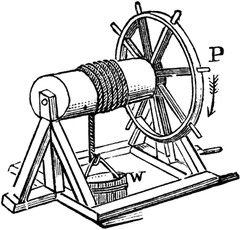
Wheel and axle

answer
-In the category of a first-class lever -In its simplest form it consists of a rod attached to a wheel so that their movements are coupled when one of the parts is turned -The wheel and axle is used either as a force multiplier (such as a doorknob, steering wheel or fishing reel) or as a distance multiplier (such as on a bicycle or the driven wheels of a car) -In the first kind of application, the larger wheel is used to create more torque (in the axle) with less force -In the second kind of application, when the axle is turned, the outside of the wheel turns at a greater linear speed that is proportional to the ratio of the radii of the wheel and axle. For example, if a bike wheel has a gear that turns eight inches in one second, and the wheel circumference is eighty inches, the wheel rotates through a distance ten times greater than the gear (and reducing the number of rotations of the pedals required) -By varying the radii of the axle and/or wheel, any amount of mechanical advantage may be gained
question
Forms of energy
answer
-Solar -Chemical -Electrical -Magnetic -Nuclear -Sound -Light -Electromagnetic -Mechanical (motion)
question
Energy
answer
-The ability to perform work -Energy transformations result when a change of form takes place -All forms of energy can be converted into other forms
question
Kinetic and potential energy
answer
-Kinetic energy: energy possessed by a moving object -An object in an unstable position has potential energy, for the position could be converted into movement Example: a baseball thrown vertically upward -Its speed decreases upward because the acceleration of gravity is acting downward -The rising ball loses kinetic energy (slows down) as it gains potential energy (rises high) -At the peak of the ball's flight, the ball is instantaneously at rest, with no kinetic energy but maximum stored potential energy -As the ball falls, the potential energy is transformed into kinetic energy and the ball accelerates
question
Thermal energy
answer
Heat can be converted to motion, and motion can produce heat
question
Law of conservation of energy
answer
Energy can be neither created nor destroy
question
Electricity
answer
-A form of energy that can be used to produce sound, light, heat, and power -Electricity exists where the number of negative electrons does not precisely equal the number of positive protons -Electrons are held in the atom by an electrical force and have an electrical charge -When the electrons are not held tightly in their atoms, the electrons can move freely and can carry electricity from one place to another
question
Current
answer
-When the electrons flow in one direction, the flowing electricity is referred to as current -An electric current is simply a flow of electrons through a wire
question
Electric circuit
answer
-The path or circuit an electric current flows -Electricity requires a complete path for the electrons to flow -If the path is broken and there are not alternative paths for the electrons to follow, the electrons will not move -Electric circuits make it possible for electric energy to operate a vast range of technology
question
Materials with high conductivity
answer
-Electricity flows easily through materials that conduct electricity -Include metals such as aluminum (Al), iron (Fe), nickel (Ni), silver (Ag), and gold (Au)
question
Materials with poor conductivity
answer
-Known as insulators -In materials that act as insulators, the electrons are held tightly inside their atoms and the electrons cannot move freely -Include plastic, rubber, glass, air, and wood
question
Static electricity
answer
-Results when electrical charges buildup or increase on the surface of a material -In static electricity, there is no current flowing as would be found in electrical outlets -When certain materials are rubbed together, electrons can move from one object to the other -A material can become negatively or positively charged if electrons in the material are gained or lost Examples: -The spark a person might get by walking across a wool rug and then touching a metal doorknob -Rubbing a balloon against your hair or against a wool sweater. Rubbing the objects together can result in the balloon becoming negatively charged and your hair becomes positively charged. Since opposite charges attract, the balloon will cling to your hair. -Lightning
question
Light
answer
-Seems to travel in perfectly straight lines as rays -The direction of a ray changes at the interface between two transparent materials, like air and water -Some of the light is reflected, the angle of reflection being equal to the angle of incidence -The portion of the light that crosses the boundary is, however, deflected in another direction, and the angle of refraction does not equal the angle of incidence -Other optical experiments are inconsistent with a simple ray theory and require that light travel as waves of electromagnetic energy
question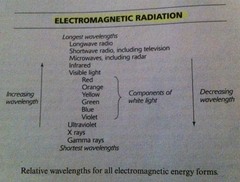
Electromagnetic radiation

answer
-An electric current also generates a magnetic field, demonstrating an intimate connection between electricity and magnetism -Recent work has united these phenomena, as well as light, into electromagnetic radiation
question
Nuclear energy
answer
Obtained by two different means, fission and fusion
question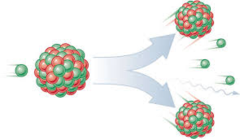
Nuclear fission

answer
-Releases energy when a heavy nucleus splits into smaller fragments -Used in power plants and atomic bombs
question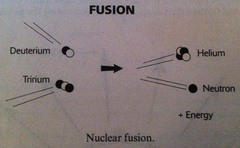
Nuclear fusion

answer
-Opposite process of nuclear fission -Yields energy when very light nuclei unite to a heavier nucleus -Stars (including the sun) derive their energy from nuclear fusion
question
Interval
answer
A difference between two temperatures or an uncertainty
question
Celsius (°C)
answer
-Temperature scale -0°C is defined as the freeing point of water and 100°C is defined as the boiling point of water (at standard atmospheric pressure) placing the boiling and freezing points of water 100° apart
question
Fahrenheit (°F)
answer
-Temperature scale named after the German physicist Daniel Gabriel Fahrenheit (1686-1736), who proposed it in 1724 -On this scale, the freezing point of water is 32°F and the boiling point is 212°F (at standard atmospheric pressure), placing the boiling and freezing points of water exactly 180° apart -A degree on the Fahrenheit scale is 1/180th of the interval between the freezing point and boiling point
question
Temperature conversions
answer
-A temperature interval of one degree F is an interval of 5/9 of a degree C -The Fahrenheit and Celsius scales coincide at -40° (i.e., -40°F and -40°C describe the same temperature) C = (5/9)(F - 32) F = (9/5)(C + 32)
question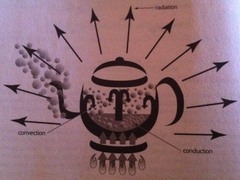
Transfer of heat

answer
-Heat tends to move from a high-temperature region to a low-temperature region -This heat transfer may occur by the mechanisms of conduction, radiation, and convection
question
Heat conduction/Thermal conduction
answer
-Transition of heat through a medium -From a region of higher temperature to a region of lower temperature -Heat energy is transferred from one material to another by direct contact -Metals are good conductors of heat Example: If a cup of coffee is stirred with a metal spoon, the spoon will quickly get hot through conduction. The molecules in the hot coffee make the atoms in the spoon vibrate quickly.
question
Thermal radiation
answer
-Transferring of heat by emission and dissemination of waves or particles -Generated when heat from the movement of charged particles within atoms is converted to electromagnetic radiation -Electromagnetic radiation emitted from the surface of an object, which is due to the object's temperature -When infrared radiation is absorbed by an object, it is changed to heat Examples: -Infrared radiation from a common household radiator or electric heater -The light emitted by a glowing incandescent light bulb
question
Convection
answer
-Transferring of heat by the circulating motion of particles (in liquid or gas) -Occurs when hot air is less dense than cool air and therefore rises -When the heat moves in a circular pattern, convection currents are formed -Heat can be transferred by the circulation of fluids due to buoyancy from changes in density Examples: -The upward flow of air due to a fire or hot object -The circulation of water in a pot that is heated from below -For a visual experience of natural convection, a glass full of hot water with red food dye may be placed in a fish tank with cold, clear, water. The convection currents of the red liquid will be seen to rise and fall and then eventually settle, illustrating the process as heat gradients are dissipated.
question
Incandescent light bulb
answer
-A source of electric light that works by incandescence -An electric current passes through a thin filament, heating it until it produces light -The enclosing glass bulb prevents the oxygen in the air from reaching the hot filament, which otherwise would be destroyed rapidly by oxidation -Sometimes called electric lamps/arc lamps
question
Fluorescent lamp/fluorescent tube
answer
-A gas-discharge lamp that uses electricity to excite mercury vapor -The excited mercury atoms produce short-wave ultraviolet light that then causes a phosphor to fluoresce, producing visible light -Unlike incandescent lamps, fluorescent lamps always require a ballast to regulate the flow of power through the lamp -However, a fluorescent lamp converts electrical power into useful light more efficiently than an incandescent lamp; lower energy costs offset the higher initial cost of the lamp -Compared with incandescent lamps, fluorescent lamps use less power for the same amount of light, generally last longer, but are bulkier, more complex, and more expensive than a comparable incandescent lamp
question
Refraction

answer
-Explains why objects appear bent as light passes from one transparent object into another -Light travels at different speeds through different objects (faster through air than through water or glass) -Responsible for rainbows and for the splitting of white light into a rainbow-spectrum as it passes through a glass prism -Glass has a higher refractive index than air and the different frequencies of light have different wavelengths (dispersion), causing them to be refracted at different angles, so that you can see them -The different frequencies correspond to different colors being observed -The various colors travel at the uniform speed c: c = 186,000 miles/second = 3 x 10^8 meters/second
question
Rainbow
answer
-After a rainstorm, the air is full of tiny drops of water -Each drop acts as a prism, splitting the light into the colors of the spectrum -Violet is the shortest wavelength; red is the longest
question
Optics
answer
In optics, refraction occurs when light waves travel from a medium with a given refractive index to a medium with another index Example: A ray of light will refract as it enters and leaves glass, assuming there is a change in the refractive index. Understanding this concept led to the invention of lenses and the refracting telescope.
question
Reflection
answer
-Occurs when light travels only in straight lines -An object is visible because light is reflected from the object into our eyes -The change in direction of a wave front at an interface between two different media so that the wave front returns to the medium from which it originated -Law of reflection: For smooth surfaces, the angle at which light is incident on the surface equals the angle at which it is reflected Examples: -The reflection of light, sound, and water waves -A mirror is an excellent tool for reflecting light
question
Renewable energy
answer
-Energy generated from natural sources (such as sunlight, wind, rain, tides, and geothermal heat) which are renewable (naturally replenished) -In 2006, about 18% of global energy consumption came from renewable sources, with 13% coming from traditional biomass materials, such as wood burning -Hydroelectricity was the next largest renewable source, providing 3%, followed by solar hot water/heating which contributed 1.3% -Modern technologies, such as geothermal energy, wind power, solar power, and ocean energy, together provided 0.8% of final energy consumption
question
Nonrenewable energy
answer
-Energy taken from finite resources that will eventually dwindle, becoming too expensive or too environmentally damaging to retrieve -Fossil fuels include coal, petroleum, and natural gas -Fossil fuels are limited and nonrenewable and contribute to global warming -When fossil fuels are burned, they release trapped energy in the form of carbon dioxide into the atmosphere -Carbon dioxide and methane are major greenhouse gases -The burning of coal also contributes to the formation of acid rain
question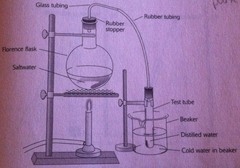
Distillation

answer
-Designed to separate substances in a liquid through vaporization -Usually carried out in an apparatus called a still, which requires a boiler, a condenser, and a receiver Example: Purify ocean water -Heat the ocean water until it reaches its boiling point -As the ocean water boils, it begins to evaporate and change from a liquid to a gas, in the form of water vapor -The gas goes through tubing to a collector container -The container sits in ice, which accelerates the condensation from water vapor back to liquid (or from a gas to a liquid) -The condensed water is pure water -Salt and other impurities remain as a residue in the original pan -Salt has a higher boiling point than water and therefore doesn't evaporate with the water
question
Crest
answer
The top of a wave's "hill"
question
Amplitude
answer
A wave's height, the distance between its resting position and its crest
question
Wavelength
answer
The distance between two consecutive points on a wave (crest to crest)
question
Pitch
answer
The pitch of a sound depends on how fast the particles of a medium vibrate
question
Frequency
answer
The number of waves produced in a given time
question
Wedge

answer
-A compound and portable inclined plane -A triangular-shaped tool used to separate two objects or portions of an object, lift an object, or hold an object in place -It functions by converting a force applied to its blunt end into forces perpendicular (normal) to its inclined surfaces -The mechanical advantage of a wedge is given by the ratio of the length of its slope to its width -Although a short wedge with a wide angle may do a job faster, it requires more force than a long wedge with a narrow angle
question
Form a question (state the problem)
answer
-A scientific question is one that can be answered on the basis of evidence and that can be measured -The question often asks, "What effect will something have — what if — and how ...?" -Examples: Why is the sky blue? What effect does salt have on the freezing temperature of water? Why does water stay in a straw when a finger is pressed over on end of the straw?
question
Develop a hypothesis
answer
-A hypothesis is an attempt to answer the question or predict the outcome -A hypothesis is a possible explanation for a set of observations -Examples: Does air pressure affect how fast fluids move? Does the length of a pendulum's swing influence its frequency?
question
Test experiment
answer
-SELECT THE MATERIALS ---List the specific materials to be used in the experiment ---This allows for replication of the experiment -SET UP THE PROCEDURE ---State the specific plan on how to test the hypothesis ---Create a written, step-by-step procedure -Determine the variables (any factor that can change in an experiment) ---Independent variable (manipulated variable): this is the one factor that will be intentionally changed during the experiment. Examples include changing the amount of salt that is added to water to determine its freezing point; introducing different soil types in germinating seeds; and changing the pendulum length to determine frequency ---Dependent variable (responding variable): This is the variable that changes as a result of the manipulated variable. The dependent variable is observed and measured. Examples include determining how long various saltwater solutions take to freeze, and determining the number of cycles a pendulum swings if the weight of the bob changes ---Variables that are controlled: These are the factors that are kept exactly the same in an experiment. In an experiment on plant growth, the variables could include amount of sunlight, type of soil, amount of water, and type of plant. Only one factor at a time is changed, while all other factors are kept constant. -COLLECT DATA (RESULTS) ---Analyze the data to look for patterns or trends ---Record measurements and observations during the experiment ---Present data in a graph, table, or another form
question
Draw conclusion
answer
-A conclusion is a summary and an explanation of the results of an experiment -Does the data support the hypothesis? If not, a new hypothesis can be formed -For example, the addition of salt lowers the freezing temperature of water, and the weight on the end of a pendulum has no effect on the time required to complete a cycle



